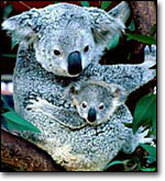Reproduction
Mammals reproduce sexually and fertilize internally. They give birth to live young, who are fed milk from mammary glands.
Monotremes
Examples: platypus, anteater
Unlike other mammals, monotremes lay eggs. A female monotreme's reproductive system shares an opening with the urinary and defecatory systems. This makes their reproductive system closer to a reptile's. They supply their young with milk from glands in their skin.
Mammals reproduce sexually and fertilize internally. They give birth to live young, who are fed milk from mammary glands.
Monotremes
Examples: platypus, anteater
Unlike other mammals, monotremes lay eggs. A female monotreme's reproductive system shares an opening with the urinary and defecatory systems. This makes their reproductive system closer to a reptile's. They supply their young with milk from glands in their skin.
Marsupials
Examples: kangaroos, koalas

Marsupials have a short gestation (pregnancy) period of about 4 or 5 weeks. After fertilization, the young is nourished in a yolk sac, which is kept apart from the mother's body by an amniotic membrane. It's nessecary to keep the yolk sac apart; otherwise the mother's immune system will recognize it as a pathogen and kill it. Unfortunately, the amniotic membrane does not allow nutrients to pass either. As a result, the offpring is underdeveloped. They crawl out to be continually fed in the mother's pouch.
Placentals
Examples: cats, dogs, humans
This group contains the most advanced mammals. Offspring are nourished from the placenta, an organ attached to the mother's uterus. It contains a rich supply of blood. It allows nutrients to pass from the mother to the offspring without letting their blood mix. This method of reproduction is beneficial for the offspring because they get to stay longer in the mother's womb until they are fully developed.
This group contains the most advanced mammals. Offspring are nourished from the placenta, an organ attached to the mother's uterus. It contains a rich supply of blood. It allows nutrients to pass from the mother to the offspring without letting their blood mix. This method of reproduction is beneficial for the offspring because they get to stay longer in the mother's womb until they are fully developed.

